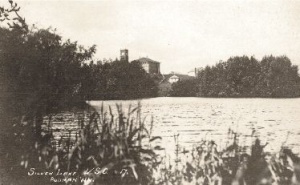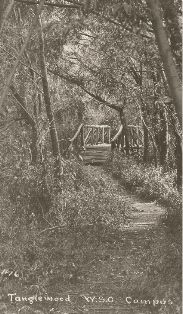Personal tools
Help
Tools
Class Notes
- Do you have news for fellow WSU alumni and other readers of Washington State Magazine? Send us your class note.
Our Story
written by alumni, faculty and friends.
NOTE: THIS IS A LEGACY SITE AND IS NOT REGULARLY MAINTAINED
Views
Vanished places: Silver Lake and the Tanglewood
From Our Story

From Washington State Magazine, Spring 2008
Imagine having a campus lake to skate on in the winter or, in fairer seasons, to picnic by. Washington State College had one: a small man-made pond in the area now occupied by Mooberry Track and the Hollingbery Field House. Officially called Silver Lake, it was informally known as Lake de Puddle.
Silver Lake became part of the College in 1899 as part of six acres purchased for $275. The school used the low-lying area to carve out a 1.6-acre water feature. Our earliest photographs of Silver Lake, such as those in President Bryan’s Historical Sketch of the State College of Washington, show the pond bordered on the east by a few shrubs. Not long after, Professor Balmer from the School of Forestry directed the transplanting on the site of some 6,000 trees and shrubs. Over the years, these plants grew into a dense thicket called The Tanglewood. A rustic wooden bridge and a series of private paths completed what must have been a lovely retreat. According to William Stimson, if students wished to meet secretly for a little “fussing” or kissing, they chose Silver Lake and the privacy afforded by The Tanglewood as their main romantic retreat.
We can further glimpse the importance of Silver Lake from “A trip though Cougarville,” a charming series of charcoal drawings and captions published in the 1926 Chinook yearbook. “In the spring and fall we have tennis and golf and in the winter skiing and skating. Silver Lake, over there on the border of the field, freezes over every year, providing a fine place for our winter sports. An occasional hole in the ice adds variety and interest without being dangerous. No one has ever been known to drown in Silver Lake.”
As the tour continues, we see an image of The Tanglewood and its rustic bridge. “This little bridge over the lake adds the note of rustic beauty desirable in the humblest of country clubs. Unlike other little rustic bridges, it does not sag with the weight of many small boys with fishing poles, for no fish pollute the waters of Silver Lake. It is used purely for ornament and to furnish water through which the sophomores may drag the freshmen in their annual tug-of-war... Need I mention the manifold uses to which an oasis such as this is put in a college town? It serves as an outdoor auditorium and a scene of many Cougarville revels as well as fulfilling its humbler duty as general picnic grounds and strolling park.”Unfortunately, the “proper atmosphere” of Silver Lake occupied precious space bordering the College’s athletic facilities. If ice skating and strolling along the lake sound idyllic, practicing football and other sports outside in the snow does not. The demise of Silver Lake and The Tanglewood came in the late 1920s with the creation of the Field House, the financing of which came through student fees. In fact, you can see the contract for its construction in Manuscripts, Archives, and Special Collections, signed by the dashing student-body president, Ed Murrow.
Our Story site map
Our Story main page | Our Story categories | Help Desk
Contact | Give | Advertise
Washington State Magazine | Washington State University | Class Notes
Our Story is coordinated by
In partnership with
Our Story and Washington State Magazine are publications of Washington State University. All rights reserved.
P.O. Box 641227, Washington State University, Pullman, WA 99164-1227 USA | wsm@wsu.edu, 509-335-2388
Accessibility | Copyright | Policies

